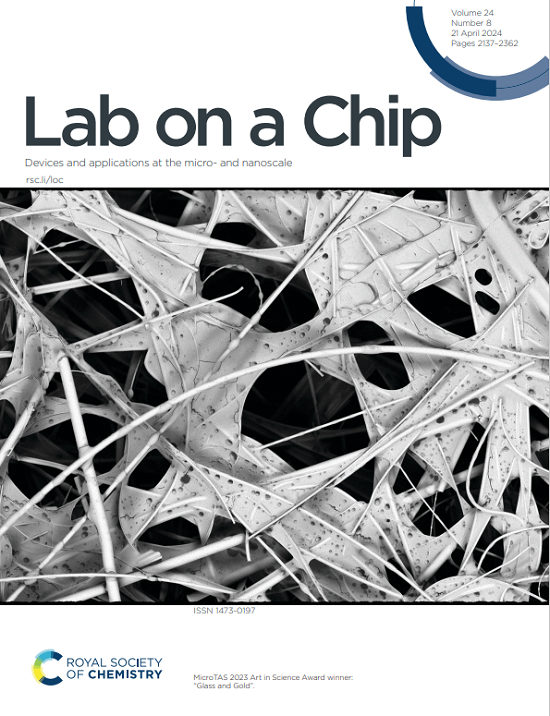Size-independent and Automated Single-Colony-Resolution Microdroplet Dispensing
IF 5.4
2区 工程技术
Q1 BIOCHEMICAL RESEARCH METHODS
引用次数: 0
Abstract
Droplet microfluidics-based high-throughput screening (HTS) enables rapid analysis of complex biological libraries, but accurate off-chip recovery of sorted "hit" droplets remains a key bottleneck. In particular, polydispersity in droplet size-common in multi-step assays-causes variation in flow velocities, where smaller droplets travel faster than larger ones. This results in the unintended co-dispensing of multiple droplets, leading to cross-contamination of hits. To address this challenge, we use blank spacing droplets as physical barriers between "hit" droplets to maintain consistent spacing during droplet transition. Each unit, or “drip,” consists of a single "hit" droplet buffered by up to 1,000 blank droplets and is dispensed individually into a well or onto agar. A distance sensor detects each drip's formation and triggers a linear motor to raise the collection plate, enabling precise and automated single-drip dispensing—even with polydisperse droplets. This approach achieves single-drip dispensing precision with 99.9% accuracy and a throughput of up to 8,640 drips per hour. We validated this system using an antimicrobial susceptibility test (AST) assay, where four resistant bacterial strains were identified from a mixed population of eleven. Our method ensures reliable and automated transfer of microfluidic hits to conventional biological assays, overcoming a key limitation in droplet HTS workflows. This system offers a scalable, cost-effective, and accurate solution for integrating microfluidic screening with downstream phenotypic analysis and paves the way for more complex droplet-based biological applications requiring precise hit recovery.尺寸独立和自动化单菌落分辨率微滴分配
基于微流控技术的液滴高通量筛选(HTS)能够快速分析复杂的生物文库,但准确地在片外回收已分类的“命中”液滴仍然是一个关键瓶颈。特别是,液滴大小的多分散性——在多步骤测定中很常见——会导致流速的变化,其中较小的液滴比较大的液滴移动得快。这将导致多个液滴的意外共同分配,导致命中的交叉污染。为了解决这一挑战,我们使用空白间距液滴作为“击中”液滴之间的物理屏障,以在液滴过渡期间保持一致的间距。每个单位,或“滴”,由单个“命中”液滴组成,由多达1000个空白液滴缓冲,并单独分配到孔中或琼脂上。距离传感器检测到每一滴的形成,并触发线性电机抬起收集板,实现精确和自动化的单滴分配,即使是多分散的液滴。这种方法可以实现99.9%的单滴点药精度,每小时可达8,640滴。我们使用抗菌药敏试验(AST)验证了该系统,其中从11个混合种群中鉴定出4个耐药菌株。我们的方法确保了可靠和自动的微流体转移到传统的生物分析中,克服了液滴高温超导工作流程中的一个关键限制。该系统为集成微流体筛选与下游表型分析提供了可扩展,经济高效且准确的解决方案,并为需要精确命中恢复的更复杂的基于液滴的生物应用铺平了道路。
本文章由计算机程序翻译,如有差异,请以英文原文为准。
求助全文
约1分钟内获得全文
求助全文
来源期刊

Lab on a Chip
工程技术-化学综合
CiteScore
11.10
自引率
8.20%
发文量
434
审稿时长
2.6 months
期刊介绍:
Lab on a Chip is the premiere journal that publishes cutting-edge research in the field of miniaturization. By their very nature, microfluidic/nanofluidic/miniaturized systems are at the intersection of disciplines, spanning fundamental research to high-end application, which is reflected by the broad readership of the journal. Lab on a Chip publishes two types of papers on original research: full-length research papers and communications. Papers should demonstrate innovations, which can come from technical advancements or applications addressing pressing needs in globally important areas. The journal also publishes Comments, Reviews, and Perspectives.
 求助内容:
求助内容: 应助结果提醒方式:
应助结果提醒方式:


